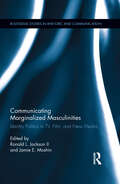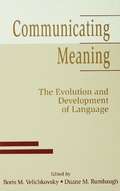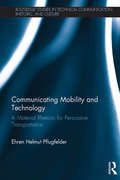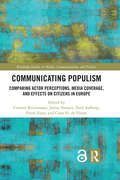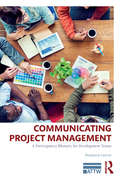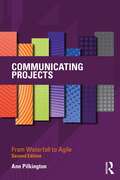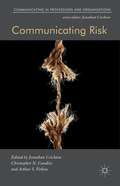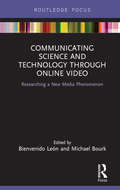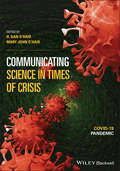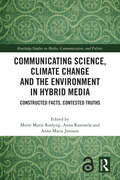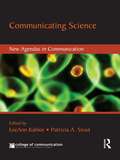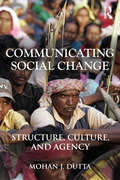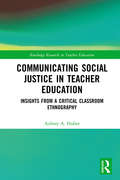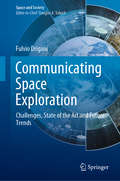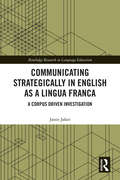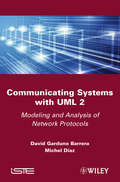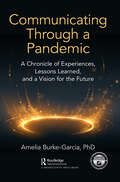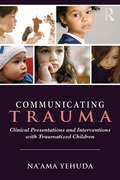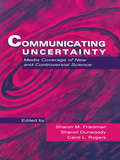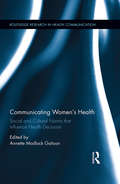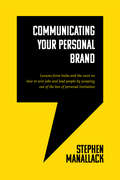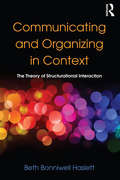- Table View
- List View
Communicating Literature: An Introduction to Oral Interpretation
by Todd V. LewisThe performance of literature discipline seems as vibrant and innovative as ever. The new sixth edition of Communicating Literature: An Introduction to Oral Interpretation reflects changes in the performance of literature since the first edition was published in 1991. The publication offers a communication-oriented definition of oral interpretation, a basic rudimentary statement of oral interpretation essentials and a link between oral interpretation and acting. Featuring a personal and direct writing style, Communicating Literature: An Introduction to Oral Interpretation: - Emphasizes the focus of performance studies needs to retain the communicative intent in literature. Each performance text should have an argument, a thesis, a premise, a theme, a communicative center. - Is suitable for lower division courses in oral interpretation, storytelling, and performance studies. - Is student friendly! Each chapter includes assignment suggestions and exercises to assist the reader in comprehending issues and concepts. - Is contemporary! The text includes a companion website that houses examples of prose, poetry, program oral interpretation, and duo interpretation. - Features NEW content! The text includes an expanded discussion and outlets / suggestions for dealing with stage fright; examples of the changing notion of what comprises a "text"; a new section on multicultural interpretation and expanded notions about competing in forensics tournament; more samples of multi-ethnic literature to demonstrate applications; career opportunities and community service outlets; and more.
Communicating Marginalized Masculinities: Identity Politics in TV, Film, and New Media (Routledge Studies in Rhetoric and Communication #11)
by Ronald L. Jackson II Jamie E. MoshinFor years, research concerning masculinities has explored the way that men have dominated, exploited, and dismantled societies, asking how we might make sense of marginalized masculinities in the context of male privilege. This volume asks not only how terms such as men and masculinity are socially defined and culturally instantiated, but also how the media has constructed notions of masculinity that have kept minority masculinities on the margins. Essays explore marginalized masculinities as communicated through film, television, and new media, visiting representations and marginalized identity politics while also discussing the dangers and pitfalls of a media pedagogy that has taught audiences to ignore, sidestep, and stereotype marginalized group realities. While dominant portrayals of masculine versus feminine characters pervade numerous television and film examples, this collection examines heterosexual and queer, military and civilian, as well as Black, Japanese, Indian, White, and Latino masculinities, offering a variance in masculinities and confronting male privilege as represented on screen, appealing to a range of disciplines and a wide scope of readers.
Communicating Meaning: The Evolution and Development of Language
by Duane M. Rumbaugh Boris M. VelichkovskyDealing specifically with the origins and development of human language, this book is based on a selection of materials from a recent international conference held at the Center of Interdisciplinary Research at the University of Bielefeld in Germany. The significance of the volume is that it testifies to paradigmatic changes currently in progress. The changes are from the typical emphasis on the syntactic properties of language and cognition to an analysis of biological and cultural factors which make these formal properties possible. The chapters provide in-depth coverage of such topics as new theoretical foundations for cognitive research, phylogenetic prerequisites and ontogenesis of language, and environmental and cultural forces of development. Some of the arguments and lines of research are relatively well-known; others deal with completely new interdisciplinary approaches. As a result, some of the authors' conclusions are in part, rather counterintuitive, such as the hypothesis that language as a system of formal symbolic transformations may be in fact a very late phenomenon located in the sphere of socio-cultural and not biological development. While highly debatable, this and other hypotheses of the book may well define research questions for the future.
Communicating Mobility and Technology: A Material Rhetoric for Persuasive Transportation (Routledge Studies in Technical Communication, Rhetoric, and Culture)
by Ehren Helmut PflugfelderWinner of the 2018 CCCC Technical and Scientific Communication Award in the category of Best Book in Technical or Scientific CommunicationResponding to the effects of human mobility and crises such as depleting oil supplies, Ehren Helmut Pflugfelder turns specifically to automobility, a term used to describe the kinds of mobility afforded by autonomous, automobile-based movement technologies and their ramifications. Thus far, few studies in technical communication have explored the development of mobility technologies, the immense power that highly structured, environmentally significant systems have in the world, or the human-machine interactions that take place in such activities. Applying kinaesthetic rhetoric, a rhetoric that is sensitive to and developed from the mobile, material context of these technologies, Pflugfelder looks at transportation projects such as electric taxi cabs from the turn of the century to modern day, open-source vehicle projects, and a large case study of an autonomous, electric pod car network that ultimately failed. Kinaesthetic rhetoric illuminates how mobility technologies have always been persuasive wherever and whenever linguistic symbol systems and material interactions enroll us, often unconsciously, into regimes of movement and ways of experiencing the world. As Pflugfelder shows, mobility technologies involve networks of sustained arguments that are as durable as the bonds between the actors in their networks.
Communicating Populism: Comparing Actor Perceptions, Media Coverage, and Effects on Citizens in Europe (Routledge Studies in Media, Communication, and Politics)
by Claes H. de Vreese James Stanyer Carsten Reinemann Frank Esser Toril AalbergThe studies in this volume conceptualize populism as a type of political communication and investigate it comparatively, focusing on (a) politicians’ and journalists’ perceptions, (b) media coverage, and (c) effects on citizens. This book presents findings from several large-scale internationally comparative empirical studies, funded by the European Cooperation in the field of Scientific and Technical Research (COST), focusing on communication and the media within the context of populism and populist political communication in Europe. The studies are based on comparative interview studies with journalists and politicians, a large-scale comparative content analysis, and a comparative cross-country experiment using nationally representative online-surveys over 15 countries. The book also includes advice for stakeholders like politicians, the media, and citizens about how to deal with the challenge of populist political communication. This enlightening volume is ‘populist’ in the best sense and will be an essential text for any scholar in political science, communication science, media studies, sociology and philosophy with an interest in populism and political communication. It does not assume specialist knowledge and will remain accessible and engaging to students, practitioners and policymakers.
Communicating Project Management: A Participatory Rhetoric for Development Teams (ATTW Series in Technical and Professional Communication)
by Benjamin LaurenCommunicating Project Management argues that the communication practices of project managers have necessarily become participatory, made up of complex strategies and processes solidly grounded in rhetorical concepts. The book draws on case studies across organizational contexts and combines individual experiences to investigate how project management relies on communication as teams develop products, services, and internal processes. The case studies also provide examples of how project managers can be understood and studied as writers, further arguing project managers must approach communication as designed experience that must be intentionally inclusive. Author Benjamin Lauren illustrates to readers how teams work together to manage projects through complex coordinative communication practices, and highlights how project managers are constantly learning and evolving by analyzing where they succeed and fail. He concludes that technical and professional communicators have a pivotal role in supporting and facilitating participative approaches to communicating project management.
Communicating Projects: From Waterfall to Agile
by Ann PilkingtonThe communication of projects to each stakeholder group is essential to their success. This book is an end-to-end guide for project managers and communication teams seeking to communicate effectively with all constituents, both internal and external. This new edition includes a number of key topical themes that build on the first edition: An introduction to project management for those new to the field, including communicating "agile", as many communication practitioners and project managers find themselves having to communicate in an agile environment, which has a language all of its own. The important role of social media and enterprise social networks as vital communication channels. The principles of change management. The role of storytelling and the importance of translating technical terminology and data into stories that clients and the wider stakeholder groups understand. Crisis communication – ensuring there is a crisis or emergency communication process in place in case it is ever needed. This highly practical book is invaluable reading for communication professionals who are increasingly managing the communication elements of projects. It also supports project managers who need to gain a practical understanding of how to design and deliver communication, as well as helping them to procure effective communication support.
Communicating Risk: Communicating in Professions and Organizations
by Jonathan Crichton Christopher N. Candlin Arthur S. FirkinsWe live in world increasingly shaped by risk, a fact underscored by recent events in the financial markets, science and technology, environmental policy and biosecurity, law enforcement and criminal justice. Risk assessment has become a central concern of governments, organisations and the professions, and the communication of risk is a crucial part of professional work. Exploring how risk is discursively constructed across these domains is therefore central to our understanding of how professional practice affects people's lives. Communicating Risk takes up this challenge, with contributions from leading researchers and practitioners that examine key issues of risk communication across diverse professional domains.
Communicating Science and Technology Through Online Video: Researching a New Media Phenomenon (Routledge Focus on Communication Studies)
by Bienvenido León Michael BourkOnline video’s unique capacity to reach large audiences makes it a powerful tool to communicate science and technology to the general public. The outcome of the international research project "Videonline," this book provides a unique insight into the key elements of online science videos, such as narrative trends, production characteristics, and issues of scientific rigor. If offers various methodological approaches: a literature review, content analysis, and interviews and surveys of expert practitioners to provide information on how to maintain standards of rigour and technical quality in video production.
Communicating Science in Times of Crisis: COVID-19 Pandemic (Communicating Science In Times Of Crisis Ser.)
by Mary John O’Hair H. Dan O’HairtyLearn more about how people communicate during crises with this insightful collection of resources In Communicating Science in Times of Crisis: COVID-19 Pandemic, distinguished academics and editors H. Dan O’Hair and Mary John O’Hair have delivered an insightful collection of resources designed to shed light on the implications of attempting to communicate science to the public in times of crisis. Using the recent and ongoing coronavirus outbreak as a case study, the authors explain how to balance scientific findings with social and cultural issues, the ability of media to facilitate science and mitigate the impact of adverse events, and the ethical repercussions of communication during unpredictable, ongoing events. The first volume in a set of two, Communicating Science in Times of Crisis: COVID-19 Pandemic isolates a particular issue or concern in each chapter and exposes the difficult choices and processes facing communicators in times of crisis or upheaval. The book connects scientific issues with public policy and creates a coherent fabric across several communication studies and disciplines. The subjects addressed include: A detailed background discussion of historical medical crises and how they were handled by the scientific and political communities of the time Cognitive and emotional responses to communications during a crisis Social media communication during a crisis, and the use of social media by authority figures during crises Communications about health care-related subjects Data strategies undertaken by people in authority during the coronavirus crisis Perfect for communication scholars and researchers who focus on media and communication, Communicating Science in Times of Crisis: COVID-19 Pandemic also has a place on the bookshelves of those who specialize in particular aspects of the contexts raised in each of the chapters: social media communication, public policy, and health care.
Communicating Science, Climate Change and the Environment in Hybrid Media: Constructed Facts, Contested Truths (Routledge Studies in Media, Communication, and Politics)
by Anna Rantasila Mette Marie Roslyng Anna Maria JönssonThis volume examines how a new hybrid mediascape represents and contributes to the construction of facts and knowledge in relation to science, environment, and climate controversies, providing a new, critical perspective to the bourgeoning field of science and environment communication.Arguing that science must be understood from an inclusive perspective, respecting public values and concerns alongside scientific arguments, the authors demonstrate how this will allow us to properly understand the role of science, truth, and factuality alongside the ethical, cultural, and political concerns about science raised in different publics. The chapters focus on the more controversial aspects of science and environmental communication: misinformation, public understandings of science and the environmental crises, vaccination, and the role of the hybrid mediascape in science, environment, and climate conflicts.Offering a much-needed interdisciplinary approach to understand the role of science of media in science and environment conflicts, this book will appeal to students and academics in the areas of media and communication, journalism, cultural studies, science, environment and risk communication, and digital media studies, as well as sociology and political science.The Open Access version of this book, available at www.taylorfrancis.com, has been made available under a Creative Commons Attribution-Non Commercial-No Derivatives (CC-BY-NC-ND) 4.0 license. An electronic version of this book is freely available, thanks to the support of libraries working with Knowledge Unlatched (KU). KU is a collaborative initiative designed to make high quality books Open Access for the public good. The Open Access ISBN for this book is 9781003479550. More information about the initiative and links to the Open Access version can be found at www.knowledgeunlatched.org.
Communicating Science: New Agendas in Communication (New Agendas in Communication Series)
by LeeAnn Kahlor Patricia StoutThis volume explores the evolution of science communication, addressing key issues and offering substance for future study. Harnessing the energies of junior scholars on the forefront of science communication, this work pushes the boundaries of research forward, allowing scholars to sample the multiple paradigms and agendas that will play a role in shaping the future of science communication. Editors LeeAnn Kahlor and Patricia Stout challenge their readers to channel the energy within these chapters to build or continue to build their own research agendas as all scholars work together – across disciplines – to address questions of public understanding of science and communicating science. These chapters are intended to inspire still more research questions, to help aspiring science communication scholars locate their own creative and original research programs, and to help veteran science communication scholars expand their existing programs such that they can more actively build interdisciplinary bridges. Crossing methodological boundaries, work from quantitative and qualitative scholars, social scientists and rhetoricians is represented here. This volume is developed for practitioners and scholars alike – for anyone who is concerned about or interested in the future of science and how communication is shaping and will continue to shape that future. In its progressive pursuit of interdisciplinary research streams – of thinking outside methodological and theoretical boxes – this book inspires science communication scholars at all levels to set a new standard for collaboration not just for science communication, but for communication research in general.
Communicating Social Change: Structure, Culture, and Agency (Routledge Communication Series)
by Mohan J. DuttaCommunicating Social Change: Structure, Culture, and Agency explores the use of communication to transform global, national, and local structures of power that create and sustain oppressive conditions. Author Mohan J. Dutta describes the social challenges that exist in current globalization politics, and examines the communicative processes, strategies, and tactics through which social change interventions are constituted in response to the challenges. Using empirical evidence and case studies, he documents the ways through which those in power create conditions at the margins, and he provides a theoretical base for discussing the ways in which these positions of power are resisted through communication processes, strategies, and tactics. The interplay of power and control with resistance is woven through each of the chapters in the book. This exceptional volume highlights the points of intersection between the theory and praxis of social change communication, creating theoretical entry points for the praxis of social change. It is intended for communication scholars and students studying activism, social movements, and communication for social change, and it will also resonate in such disciplines such as development, sociology, and social work, with those who are studying social transformations.
Communicating Social Justice in Teacher Education: Insights from a Critical Classroom Ethnography (Routledge Research in Teacher Education)
by Aubrey A. HuberEvolving out of ethnographic fieldwork, this text examines how ideas of social justice are articulated and communicated by pre-service teachers and graduate teaching assistants in the US. By positing the concept of "help" as a central tenet of social justice within teacher education, this volume offers a unique performative analysis of how the concept is communicatively constituted in teacher education and training. Using a social justice framework, the book examines the ways in which new teachers contend with their identities as educators, and demonstrates how these communicative performances influence pre-service and new teachers’ perceptions of their role, as well as their responsibility to engage with social justice and critical approaches in the classroom. This text will benefit researchers, academics, and educators in higher education with an interest in teacher education, critical communication studies, and the sociology of education more broadly. Those specifically interested in teacher training, mentoring, and social justice in the classroom will also benefit from this book.
Communicating Social Support
by Daena J. GoldsmithWe often turn to our friends, family, spouses, and partners for help in coping with daily stress or major crises. Daena Goldsmith provides a communication-based approach for understanding why some conversations about problems are more helpful than others. In contrast to other research on the social support processes, Goldsmith focuses on interpersonal communication--what people say and how they say it, as well as their reactions to the conversations. Her studies cover adults of all ages and various kinds of stresses, ranging from everyday hassles to serious illnesses and other major crises.
Communicating Space Exploration: Challenges, State of the Art and Future Trends (Space and Society)
by Fulvio DriganiThis book offers an enlightening analysis of the ways in which the communication of space explorations has evolved in response to political and social developments and the availability of new media and communication tools. Important challenges to effective communication are discussed, including the diversity of audiences, the risks associated with space missions, and continuing skepticism about the benefits of space research despite the many associated day-to-day applications. In addition, future trends in communication are examined with reference to likely trends in space exploration over the coming century. Besides space communication for the public, the need for targeted messaging to each group of stakeholders – decision makers, media, opinion leaders, the scientific community, and industry – is analyzed in detail. A series of case studies of particular space missions, both successful and unsuccessful, is presented to illustrate key issues. The book has significant implications for the communication of science in general and will be of interest to a wide audience, including space scientists, science communication professionals, people fascinated by exploration and discovery, stakeholders, and educators.
Communicating Strategically in English as a Lingua Franca: A Corpus Driven Investigation (Routledge Research in Language Education)
by Janin JafariThere have been noticeable demographic changes recently in the use of English around the world. English as a medium of communication is now the contact language of native speakers from many diverse speech communities who interact with each other in multilingual contexts. The use of English as a lingua franca (ELF) and its implications has become a hot topic in applied linguistics and English studies. Communicating Strategically in English as a Lingua Franca reflects the growing interest in achieving communicative effectiveness in ELF situations and provides a comprehensive account of recent empirical findings in the field of ELF. It analyzes and interprets the author's own large corpus of naturally occurring spoken interactions and focuses on identifying innovative employments in the communicative strategies and pragmatics of speakers involved in ELF interactions. In doing so, this book makes a considerable contribution to the growing field of empirical studies in ELF. It explores the usage of pragmatic strategies and highlights their significant role in communicative effectiveness in ELF interactions. In showing the processes of classifying communication strategies involved in the identification of newly observed communication strategies, this book will be of great interest to English linguists, applied linguists, graduate and undergraduate students of English, English Language Teaching material developers and teachers of English.
Communicating Systems with UML 2: Modeling and Analysis of Network Protocols (Wiley-iste Ser.)
by David Garduno Barrera Michel DiazThis book gives a practical approach to modeling and analyzing communication protocols using UML 2. Network protocols are always presented with a point of view focusing on partial mechanisms and starting models. This book aims at giving the basis needed for anybody to model and validate their own protocols. It follows a practical approach and gives many examples for the description and analysis of well known basic network mechanisms for protocols. The book firstly shows how to describe and validate the main protocol issues (such as synchronization problems, client-server interactions, layer organization and behavior, etc.) in an easy and understandable way. To do so, the book considers and presents the main traditional network examples (e.g. unidirectional flows, full-duplex com-munication, error recovering, alternating bit). Finally, it presents the outputs resulting from a few simulations of these UML models. Other books usually only focus either on teaching UML or on analyzing network protocols, however this book will allow readers to model network protocols using a new perspective and integrating these two views, so facilitating their comprehension and development. Any university student studying in the field of computing science, or those working in telecommunications, embedded systems or networking will find this book a very useful addition.
Communicating Through a Pandemic: A Chronicle of Experiences, Lessons Learned, and a Vision for the Future
by Amelia Burke-GarciaOutbreaks, epidemics, and pandemics are nothing new. Over the last several decades, we have been through numerous—Zika, Ebola, H1N1. The COVID‐19 pandemic, however, has challenged us like never before. During this time, we have struggled to work remotely, to balance work and children’s school schedules, and to manage finances in the face of lost or furloughed jobs. We have worried about our loved ones getting sick and being able to support themselves, and we have faced the loneliness that comes with social distancing. It has affected us individually and globally—but we have not all experienced this pandemic in exactly the same way. Some communities have been hit harder in terms of sickness and death rates from COVID‐19. Many have felt the economic pressures of the pandemic more acutely. Still others have struggled disproportionately with the mental health impacts. Context has mattered in this pandemic. There is one common thread that runs through everything we have experienced though: the role that communication has played in managing this pandemic. Whether we are talking about communication about the virus and mitigation strategies, communication between friends and family, the urgent crisis resulting in mis- and dis-information, our complex and diffuse media environment, or new workplace communication strategies, communication has been front and center in this pandemic. The role of communication has been integral to the success and failure of our ability to respond and adapt to and begin to recover from this pandemic—as individuals, collectively as communities, and as countries. As a result, issues such as preparedness, misinformation, literacy and comprehension of virus and vaccine science, health equity and mental health have all gained increased awareness during this time. This book unpacks the many and varied roles that communication has played over the course of this pandemic, in order to help public health professionals, marketers and health communicators, and policymakers alike to understand what we have been through, what has worked well, and what we have struggled with. It will help us learn from our experiences, so we communicate through pandemics more successfully in the future.
Communicating Through a Pandemic: A Chronicle of Experiences, Lessons Learned, and a Vision for the Future
by Amelia Burke-GarciaSilver Award Winner from the Nonfiction Authors Association“The book is equal parts ‘how-to guide’ for effective health communications and a memoir of surviving a global pandemic. I appreciated reading about Burke-Garcia’s personal reflections about her experiences of isolation, uncertainty and exhaustion during quarantine. She shares her experiences and observations in a relatable and accessible manner. Knowing about the author’s personal struggles made me lean into what she had to share from her professional experience leading a communications campaign. Throughout the book, she explores data and research about communication needs among people from diverse groups and presents a sensible critique of the media environment.” – Nonfiction Book AwardOutbreaks, epidemics, and pandemics are nothing new. Over the last several decades, we have been through numerous—Zika, Ebola, H1N1. The COVID‐19 pandemic, however, has challenged us like never before. During this time, we have struggled to work remotely, to balance work and children’s school schedules, and to manage finances in the face of lost or furloughed jobs. We have worried about our loved ones getting sick and being able to support themselves, and we have faced the loneliness that comes with social distancing.It has affected us individually and globally—but we have not all experienced this pandemic in exactly the same way. Some communities have been hit harder in terms of sickness and death rates from COVID‐19. Many have felt the economic pressures of the pandemic more acutely. Still others have struggled disproportionately with the mental health impacts. Context has mattered in this pandemic.There is one common thread that runs through everything we have experienced though: the role that communication has played in managing this pandemic. Whether we are talking about communication about the virus and mitigation strategies, communication between friends and family, the urgent crisis resulting in mis- and dis-information, our complex and diffuse media environment, or new workplace communication strategies, communication has been front and center in this pandemic.The role of communication has been integral to the success and failure of our ability to respond and adapt to and begin to recover from this pandemic—as individuals, collectively as communities, and as countries. As a result, issues such as preparedness, misinformation, literacy and comprehension of virus and vaccine science, health equity and mental health have all gained increased awareness during this time.This book unpacks the many and varied roles that communication has played over the course of this pandemic, in order to help public health professionals, marketers and health communicators, and policymakers alike to understand what we have been through, what has worked well, and what we have struggled with. It will help us learn from our experiences, so we communicate through pandemics more successfully in the future.
Communicating Trauma: Clinical Presentations and Interventions with Traumatized Children
by Na'Ama YehudaCommunicating Trauma explores the various aspects of language and communication and how their development can be affected by childhood trauma and overwhelm. Multiple case-study vignettes describe how different kinds of childhood trauma can manifest in children's ability to relate, attend, learn, and communicate. <P><P> These examples offer ways to understand, respond, and support children who are communicating overwhelm. In this book, psychotherapists, speech-language pathologists, social workers, educators, occupational and physical therapists, medical personnel, foster parents, adoption agencies, and other child professionals and caregivers will find information and practical direction for improving connection and behavior, reducing miscommunication, and giving a voice to those who are often our most challenging children.
Communicating Uncertainty: Media Coverage of New and Controversial Science (Routledge Communication Series)
by Sharon M. Friedman Sharon Dunwoody Carol L. RogersExploring the interactions that swirl around scientific uncertainty and its coverage by the mass media, this volume breaks new ground by looking at these issues from three different perspectives: that of communication scholars who have studied uncertainty in a number of ways; that of science journalists who have covered these issues; and that of scientists who have been actively involved in researching uncertain science and talking to reporters about it. In particular, Communicating Uncertainty examines how well the mass media convey to the public the complexities, ambiguities, and controversies that are part of scientific uncertainty. In addition to its new approach to scientific uncertainty and mass media interactions, this book distinguishes itself in the quality of work it assembles by some of the best known science communication scholars in the world. This volume continues the exploration of interactions between scientists and journalists that the three coeditors first documented in their highly successful volume, Scientists and Journalists: Reporting Science as News, which was used for many years as a text in science journalism courses around the world.
Communicating Women's Health: Social and Cultural Norms that Influence Health Decisions (Routledge Research in Health Communication)
by Annette Madlock GatisonThis volume explores the conditions under which women are empowered, and feel entitled, to make the health decisions that are best for them. At its core, it illuminates how the most basic element of communication, voice, has been summarily suppressed for entire groups of women when it comes to control of their own sexuality, reproductive lives, and health. By giving voice to these women’s experiences, the book shines a light on ways to improve health communication for women. Bringing together personal narratives, key theory and literature, and original qualitative and quantitative studies, the book provides an in-depth comparative picture of how and why women’s health varies for distinct groups of women. Organized into four parts—historical influences on patient and provider perceptions, breast cancer the silence and the shame, make it taboo: mothering, reproduction, and womanhood, and sex, sexuality, relational health, and womanhood—each section is introduced with a brief synthesis and discussion of the key questions addressed across the chapters.
Communicating Your Personal Brand: Lessons from India and the west on how to win jobs and lead people by jumping out of the box of personal limitation
by Stephen ManallackCommunicating Your Personal Brand by Stephen Manallack combines lessons from India and the west on how to win jobs and lead people. • How to jump out of the box of personal limitation • 20 soft skills for 21st century global communicators • Win that special job - Gain the promotion you deserve • Change the way you see yourself, and the way others see you • Communicate across borders • Have the mindset of a leader - lessons from India • A must read for young executives, professionals, students and those on the career path Stephen Covey: "Communication is the most important skill in life" Sir Richard Branson: "Communication is the most important skill any leader can possess"
Communicating and Organizing in Context: The Theory of Structurational Interaction (Routledge Communication Series)
by Beth Bonniwell HaslettCommunicating and Organizing in Context integrates Giddens’ structuration theory with Goffman’s interaction order and develops a new theoretical base—the theory of structurational interaction—for the analysis of communicating and organizing. Both theorists emphasize tacit knowledge, social routines, context, social practices, materiality, frames, agency, and view communication as constitutive of social life and of organizing. Thus their integration in structurational interaction provides a coherent, communication-centric approach to analyzing communicating, organizing and their interrelationships. This book will be a valuable resource for students and scholars as an orientation to the field of organizational communication and as an integration of organizing and communicating. It will also be useful for practitioners as a tool for understanding how conceptual frames limit possibilities and constitute the nature of organizing and members' participation in organizations.

